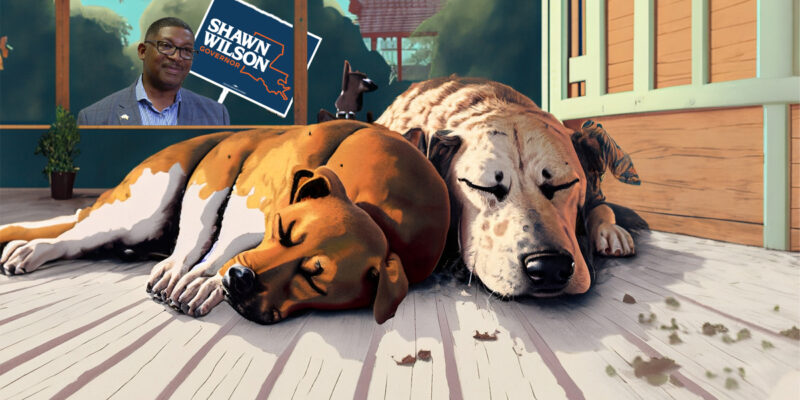Perceived lesser quality of gubernatorial candidates except for the front runner explains why voting in Louisiana’s contest for its top job likely will decline markedly this cycle.
The latest statewide figures for registration by party and race are Democrats at 38.7 percent, Republicans at 33.8 percent, and others at 28.5 percent, with whites comprising 62.8 percent, blacks 31.2 percent, and others 6 percent. This contrasts with 2019 figures at the same time of year of 42.4 percent Democrats, 31 percent Republicans, and 27.6 other/no parties, and whites being 63.5 percent, blacks 31.3 percent, and others 5.2 percent. Reflecting the population drain throughout the two terms of Democrat Gov. John Bel Edwards, only 8,000 more voters were registered now than four years ago.
However, early in-person voting was down considerably compared to 2019, after years of increasing proportions. It was off by nearly a fifth, or 66,000. Louisiana has had early no-excuse voting since 2008, and throughout this period analysts have grappled with understanding year-over-year changes in numbers and proportions in terms of whether these would predict eventual turnout and whether any party benefitted. It has been assumed that a learning curve existed for voters which caused largely a substitution effect; i.e., almost all early voters would have voted on election day, but increases from similar election to election were confounded by the learning curve of more voters realizing they could vote and then taking advantage of voting early. But dropping off in early voting, and considerably, unmistakably denotes a lack of enthusiasm compared to the previous similar election, as it seems unlikely that those intending to vote would delay deliberately their vote choice.
Compared to 2019, when Democrats were 43.8 percent, Republicans 41.5 percent and others 14.7 percent, and whites made up 72 percent, blacks 25.4 percent, and others 2.6 percent, of early voters, in 2023 Democrats had only 40.1 percent with Republicans at 44.6 percent and others/none at 15.3 percent with whites having 71 percent, blacks 26.1 percent, and others 2.9 percent. In raw numbers, Democrats fell nearly 30,000, less than the white decline of 33,000 while Republicans dropped just 5,000 and blacks only 7,000.
If assuming the exact same forces at work this upcoming governor’s election as with its 2019 counterpart, back then early in-person voting accounted for 11.5 percent of the electorate which eventually cast over 1.343 million votes or 45.9 percent of the electorate, then this year with that early voting comprising 9.2 percent translates to only 36.7 percent turnout and just 1.091 million cast. By contrast, 2015 saw turnout of 39.2 percent, and 2011 of 32.8 percent.
This overview points to two factors explaining the potential 20 percent drop in turnout. First and foremost, Democrats have a pair of weak main candidates from which to choose. Former cabinet member Shawn Wilson is the most leftist major candidate ever to run, even more than Edwards, which repels traditional liberal populists that were the party’s backbone for a century. And their alternative, independent trial lawyer Hunter Lundy who is a social conservative but who backs classic leftist redistributionist politics, comes across as too raw and simple.
Advertisement
Neither candidate excites the base beyond activists, something that manifests clearest in the statistics as a big drop in white Democrats voting early. Even blacks, who tend to be more socially conservative as a whole than in most states especially outside of the large metropolitan areas, aren’t excited about Wilson, the first major black gubernatorial candidate in the state’s history not competing against a major white Democrat.
The other is the dominance of GOP Atty. Gen. Jeff Landry, endorsed by most conservative politicians and organizations and the Republican Party, and well-funded far above other GOP alternatives. This has created the impression that he’s already won entry into the runoff, if not the race itself, which discourages casual voters not interested much in outcomes of other offices and in particular Republicans not enthusiastic about him but who see no viable alternative from within the party. Even some casual voters who like Landry figure he has it in the bag and they won’t need to show up for him to win.
This makes 2023 much like 2011, when the popular GOP incumbent Gov. Bobby Jindal so dominated the field that no quality candidate would run against him. Then, some Republicans stayed home thinking a general election victory was a sure thing (they were right) and Democrats without a real candidate skipped that one (a number of Board of Elementary and Secondary Education and state legislative contests had much higher turnouts, since these were seen as more competitive).
If Landry doesn’t win outright in the general election – possible, but not probable – and thereby faces Wilson in the runoff, look for a noticeable decline in that contest as well. Like it or not, competitiveness matters in making people care about elections.
Advertisement
Advertisement

